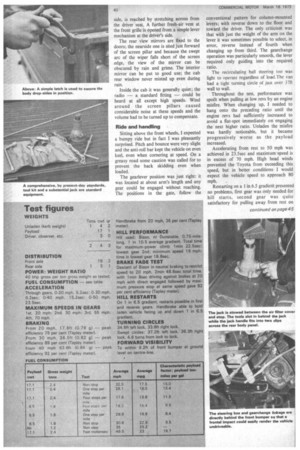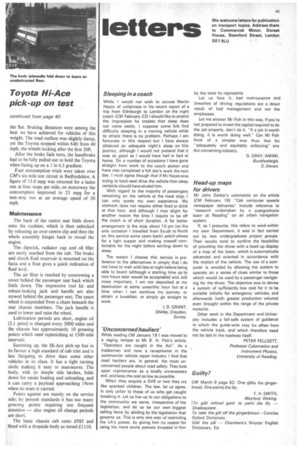Toyota Hi-Ace
Page 40

Page 41

Page 42

Page 47

If you've noticed an error in this article please click here to report it so we can fix it.
newt
yload pick-up
by Trevor Longcroft
TOYOTA of Japan introduced its Hi-Ace range to Britain in August 1972 and although the company makes and imports a van version, it is sold only to Toyota's authorized bodybuilders who convert these vehicles into caravans. British-built Luton bodies have recently become available on the Toyota chassis/cab but for Our test we chose a standard pick-up truck. The pick-up has a 911 6ip. wheelbase and is available in only one specification.
By British standards, the cab trim and fittings — including a radio — are luxurious, but some might consider the "1600" engine to be underpowered for the allowable 2.25-ton gross vehicle weight. The four-cylinder petrol engine is mounted
belo.w the rear of the cab, and has a gros! rating of 90 bhp at 5400 rpm and gros! torque of 98 lb ft at 300 rpm. The drive lim is a conventional design using a live real axle.
The body is pillarless so that ai unobstructed flat platform is left when thl side and tail boards are let down.
Driver comfort The seats are mounted directly above th wheel arches and I found getting in eas enough by using the grab handle fixed E the forward corner of the door opening.
The driving seat adjusts forward an back but not up or down. For a average-height person like myself, the sm height was about right, but six-footers will not easily be able to see the road dead ahead because the windscreen top-edge is low.
Three individual seats stretch across the full width of the cab; the centre one is on the engine cover and is not as comfortable as the other two which have larger seat squabs and integral headrests. The headrest on the driver's seat seems to be there more for looks than comfort, because I found the angle of the headrest to the squab to be uncomfortable, and I could make little use of the headrest while driving.
The column-mounted gearlever and dash-mounted handbrake give an uncluttered floor which allows good across-cab access, and gives the second passenger good foot-room.
A panel set in the facia ahead of the driver houses two large dials containing all of the instruments. The speedometer has an indicator bulb which comes on whenever the handbrake is engaged. The other dial contains the fuel and coolant temperature gauges and the oil and ignition warning lights.
A two-stage switch controlling panel, parking and headlights at the bottom right of the facia, is easily confused with a similar two-stage heater fan boost control mounted just beneath it. Choke, combined two-speed windscreen wiper/washer switch and cigarette lighters are fitted between the column and centre facia.
A simple two-way flap at the base of the heater — slung beneath the centre of the facia — directs air either into the interior or onto the screen, a separate lever on a vent adjacent to the heater allows fresh air either directly into the cab, into the heater unit or to be shut-off. This vent, at the passenger side, is reached by stretching across from the driver seat. A further fresh-air vent at the front grille is opened from a simple lever mechanism at the driver's side.
The rear view mirrors are fixed to the doors; the nearside one is sited just forward of the screen pillar and because the swept arc of the wiper falls short of the screen .edge, the view of the mirror can be obscured by rain and grime. The interior mirror can be put to good use; the cab rear window never misted up even during rain.
Inside the cab it was generally quiet; the radio a standard fitting could be heard at all except high speeds. Wind around the screen pillars caused considerable noise at these speeds and the volume had to be turned up to compensate.
Ride and handling Sitting above the front wheels, I expected a bumpy ride but in fact I was pleasantly surprised. Pitch and bounce were very slight and the anti-roll bar kept the vehicle on even keel, even when cornering at speed. On a greasy road some caution was called for to prevent the back skidding even when loaded.
The gearlever position was just right: it was located at about arm's length and any gear could be engaged without reaching. The positions in the gate, follow the conventional pattern for column-mounted levers; with reverse down to the floor and toward the driver. The only criticism was that with just the weight of the arm on the lever it was sometimes possible to select, in error, reverse instead of fourth when changing up from third. The gearchange operation was particularly smooth, the lever required only guiding into the required ratio.
The recirculating ball steering too was light to operate regardless of lowl.The Van had a tight turning circle of just over 37ft wall to wall.
Throughout the test, performance was spoilt when pulling at low revs by an engine misfire. When changing up, I needed to hang onto the preceding ratio' until the engine revs had sufficiently increased to avoid a flat-spot immediately on engaging the next higher ratio. Unladen the misfire was hardly noticeable, but it became progressively worse as the payload increased.
Accelerating from rest to 50 mph was achieved in 23.5sec and maximum speed is in excess of 70 mph. High head winds prevented the Toyota from exceeding this speed, but in better conditions I would expect the vehicle speed to approach 80 mph. .
Restarting on a I in 6.5 gradient presented no problems, first gear was only needed for hill starts, second gear was quite satisfactory for pulling away from rest on the flat. Braking distances were among the best we have achieved for vehicles of this weight. The road surface was slightly damp, yet the Toyota, stopped within 64ft from 40 mph, the wheels locking after the first 20ft.
After the brake fade tests, the handbrake had to be fully pulled out to hold the Toyota when facing up on a 1 in 6.5 gradient.
Fuel consumption trials were taken over CM's six-mile test circuit in Bedfordshire. A figure of 13.8 mpg was returned for a laden run at four stops per mile, on motorway the consumption improved to 23 mpg for a non-stop run at an average speed of' 50 mph.
Maintenance The back of the centre seat folds down onto the cushion, which is then unlocked by releasing an over-centre clip and then the whole assembly hinges back to reveal the engine. • The dipstick, radiator cap and oil filler are easily reached from the cab. The brake and clutch fluid reservoir is mounted on the facia and a float gives a quick indication of fluid level.
The air filter is reached by unscrewing a cover behind the passenger seat back which folds down. The impressive tool kit and robust-looking jack and handle are also stowed behind the passenger seat. The spare wheel is suspended from a chain beneath the rear chassis members. The jack handle is used to lower and raise the wheel.
Lubrication periods are short, engine oil (3.1 pints) is changed every 3000 miles and the chassis has approximately 10 greasing points which need replenishing at 1500-mile intervals. •
Summing up, the Hi-Ace pick-up has in its favour a high standard of cab trim and is less fatiguing to drive than some other vehicles in its class. It has a tight turning circle making it easy to manoeuvre. The body, with its simple side latches, folds down for easier loading and unloading, and it can carry a payload approaching 19cwt when no mate is carried.
Points against are niainly on the service side: by present standards it has too many greasing points requiring too frequent attention — also engine ciil change periods are short.
The basic chassis cab costs 085 and fitted with a dropside body as tested £1110.
Test figures
DISTRI BUTION
Front axle 19 2
Rear axle 1 5 1
POWER: WEIGHT RATIO
40 bhp gros,, per tor, gross weight as tested. FUEL CONSUMPTION -see table ACCELERATION Through gears, 0-20 mph, 5.2sec0 30 mph, 9,2sec; 0-40 mph, 15.2sec: 0-50 mph, 23 5sec
MAXIMUM SPEEDS IN GEARS
1 st. 20 mph. 2nd 30 mph. 3rd 55 mph: 4th 70 mph
BRAKING
From 20 mph, 17.6ft 10 76 g) peak efficiency 79 per cent (Tapley meted
From 30 mph, 36.5ft 10.82 g) peak efficiency 89 per cent (Tapley meter).
From 40 mph 63 eft (0.84 g) peak efficiency, 92 per cent tTapley meter).
Handbrake from 20 mph, 36 per cent (Tapley meter).
HILL PERFORMANCE
Hill used: Bison, or Dunstable, 0.75-milelong, 1 in 10.5 average gradient. Total time for maximum-power climb 1min 22.5sec: lowest gear 2nd: minimum speed 19 mph: time in lowest gear 18.8see.
BRAKE FADE TEST
Descent of Bison in neutral braking to restrict speed to 20 mph, 2rnin 48.8sec total time, with 1min 8sec driving against brakes at 20 mph with direct engaged followed by maxi, mum pressure stop at same speed gave 82 per cent efficiency (Tapley meter).
HILL RESTARTS
On 1 in 6.5 gradient. restarts possible in first and reverse gears. Handbrake able to hold laden vehicle facing up and down 1 in 6.5 gradient.
TURNING CIRCLES
34.6ft left lock. 33.8ft right lock.
Swept circles: 37.2ft left lock, 36.3ft right lock. 4.6 turns from lock to lock.
FORWARD VISIBILITY
To within 9.2ft of front bumper at ground level on centre-line.
























































































































